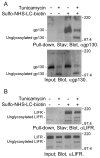N-glycans modulate the activation of gp130 in mouse embryonic neural precursor cells
- PMID: 19501045
- PMCID: PMC3005145
- DOI: 10.1016/j.bbrc.2009.05.132
N-glycans modulate the activation of gp130 in mouse embryonic neural precursor cells
Abstract
gp130 is a ubiquitously expressed glycoprotein and signal transducer of interleukin 6 family of cytokines. It has been reported that gp130 has 11 potential N-glycosylation sites in the extracellular domain, and nine of them are actually N-glycosylated. However, the structure and functional role of the carbohydrate chains carried by gp130 are totally unknown. In this study, we examined the functional role of N-glycans of gp130 in mouse neuroepithelial cells. In neuroepithelial cells treated with tunicamycin, an N-glycosylation inhibitor, unglycosylated form of gp130 was detected. The unglycosylated gp130 was not phosphorylated in response to leukemia inhibitory factor stimulation. Although the unglycosylated gp130 was found to be expressed on the cell surface, it could not form a heterodimer with leukemia inhibitory factor receptor. These results suggest that N-glycans are required for the activation, but not for the localization, of gp130 in neuroepithelial cells.
Figures




Similar articles
-
The inhibition of N-glycosylation of glycoprotein 130 molecule abolishes STAT3 activation by IL-6 family cytokines in cultured cardiac myocytes.PLoS One. 2014 Oct 23;9(10):e111097. doi: 10.1371/journal.pone.0111097. eCollection 2014. PLoS One. 2014. PMID: 25340554 Free PMC article.
-
N-linked glycosylation is essential for the stability but not the signaling function of the interleukin-6 signal transducer glycoprotein 130.J Biol Chem. 2010 Jan 15;285(3):1781-9. doi: 10.1074/jbc.M109.075952. Epub 2009 Nov 13. J Biol Chem. 2010. PMID: 19915009 Free PMC article.
-
Complex N-linked glycans on Asn-89 of Kaposi sarcoma herpes virus-encoded interleukin-6 mediate optimal function by affecting cytokine protein conformation.J Biol Chem. 2009 Oct 23;284(43):29269-82. doi: 10.1074/jbc.M109.039115. Epub 2009 Aug 18. J Biol Chem. 2009. PMID: 19690161 Free PMC article.
-
Functional properties of extracellular domains of transducer receptor gp130.Biochemistry (Mosc). 2011 Apr;76(4):394-406. doi: 10.1134/s000629791104002x. Biochemistry (Mosc). 2011. PMID: 21585315 Review.
-
Conditional gp130 deficient mouse mutants.Semin Cell Dev Biol. 2008 Aug;19(4):379-84. doi: 10.1016/j.semcdb.2008.07.001. Epub 2008 Jul 17. Semin Cell Dev Biol. 2008. PMID: 18687405 Review.
Cited by
-
The biology of interleukin-6 family cytokines is regulated by glycosylation.Biochem J. 2025 May 21;482(10):535-551. doi: 10.1042/BCJ20240769. Biochem J. 2025. PMID: 40663802 Free PMC article. Review.
-
The inhibition of N-glycosylation of glycoprotein 130 molecule abolishes STAT3 activation by IL-6 family cytokines in cultured cardiac myocytes.PLoS One. 2014 Oct 23;9(10):e111097. doi: 10.1371/journal.pone.0111097. eCollection 2014. PLoS One. 2014. PMID: 25340554 Free PMC article.
-
N-linked glycosylation is essential for the stability but not the signaling function of the interleukin-6 signal transducer glycoprotein 130.J Biol Chem. 2010 Jan 15;285(3):1781-9. doi: 10.1074/jbc.M109.075952. Epub 2009 Nov 13. J Biol Chem. 2010. PMID: 19915009 Free PMC article.
-
2-Deoxy-d-glucose induces deglycosylation of proinflammatory cytokine receptors and strongly reduces immunological responses in mouse models of inflammation.Pharmacol Res Perspect. 2022 Apr;10(2):e00940. doi: 10.1002/prp2.940. Pharmacol Res Perspect. 2022. PMID: 35212163 Free PMC article.
-
Involvement of beta1-integrin up-regulation in basic fibroblast growth factor- and epidermal growth factor-induced proliferation of mouse neuroepithelial cells.J Biol Chem. 2010 Jun 11;285(24):18443-51. doi: 10.1074/jbc.M110.114645. Epub 2010 Apr 6. J Biol Chem. 2010. PMID: 20371608 Free PMC article.
References
-
- Taga T, Kishimoto T. Gp130 and the interleukin-6 family of cytokines. Annu Rev Immunol. 1997;15:797–819. - PubMed
-
- Taga T, Hibi M, Hirata Y, Yamasaki K, Yasukawa K, Matsuda T, Hirano T, Kishimoto T. Interleukin-6 triggers the association of its receptor with a possible signal transducer, gp130. Cell. 1989;58:573–581. - PubMed
Publication types
MeSH terms
Substances
Grants and funding
LinkOut - more resources
Full Text Sources

